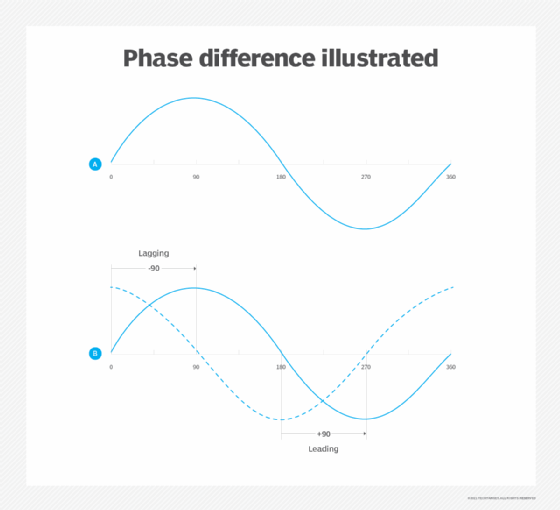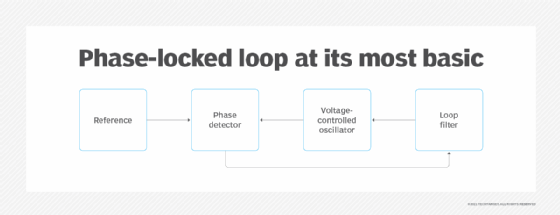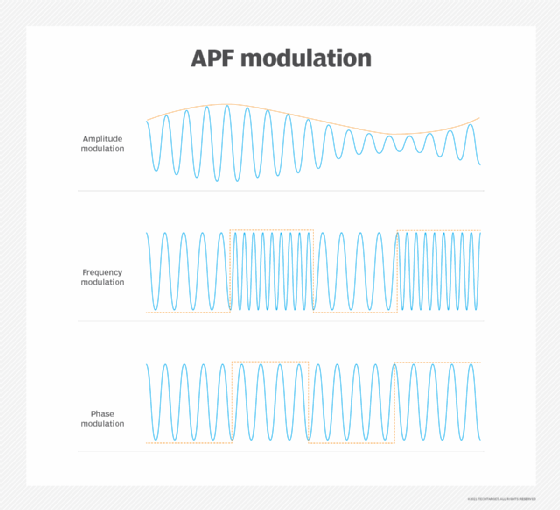phase-locked loop (PLL)
What is a phase-locked loop (PLL)?
A phase-locked loop (PLL) is an electronic circuit with a voltage or voltage-driven oscillator that constantly adjusts to match the frequency of an input signal. PLLs are used to generate, stabilize, modulate, demodulate, filter or recover a signal from a "noisy" communications channel where data has been interrupted.
PLLs are widely used in wireless or radio frequency (RF) applications, including Wi-Fi routers, broadcast radios, walkie-talkie radios, televisions and mobile phones.
At its simplest, a phase-locked loop is a closed-loop feedback control circuit that's both frequency- and phase-sensitive. A PLL is not a single component, but a system that consists of both analog and digital components -- interconnected in a "negative feedback" configuration. Consider it analogous to an elaborate operational amp (op amp)-based amplifier circuit.
What is a phase-locked loop used for?
The main goal of a PLL is to synchronize the output oscillator Signal with a reference signal. Even if the two signals have the same frequency, their peaks and troughs may not occur in the same place. Simply put, they do not reach the same point on the waveform at the same time.
Known as the phase difference, this is measured as the angle between the signals. For signals with varying frequencies, the phase difference between them will always vary, which means that one signal will lag or lead the other by a varying amount.

A PLL reduces phase errors between output and input frequencies. When the phase difference between these signals is zero, the system is said to be "locked." And this locking action depends on the PLL's ability to provide negative feedback -- i.e., route the output signal back to the phase detector.
In addition to synchronizing the output and input frequencies, a PLL also helps establish the input-output phase relationship to generate the appropriate control voltage. Therefore, it helps achieve both frequency and phase lock in a circuit.
Key components of a phase-locked loop
A PLL consists of three key components:
- Phase detector (also known as a phase comparator or mixer). It compares the phases of two signals, and generates a voltage according to the phase difference. It multiplies the reference input and the voltage-controlled oscillator output.
- Voltage-controlled oscillator. Generates a sinusoidal signal, whose frequency closely matches the center frequency provided by the low-pass filter.
- Low-pass filter. A kind of loop filter that attenuates the high-frequency alternating current (AC) component of the input signal to smoothen and flatten the signal to make it more DC-like.
Here, the phase detector functions as an analog multiplier, the voltage-controlled oscillator as a gain block, and the low-pass filter as a lag block.
Together, the phase-locked loop, voltage-controlled oscillator, reference oscillator and phase comparator comprise a frequency synthesizer -- an electronic system that produces a range of frequencies from a single fixed oscillator. Wireless equipment that use this type of frequency control are said to be frequency-synthesized.
Other frequency-synthesized devices include:
- mobile phones
- satellite receivers
- GPS systems
How a phase-locked loop works
The underlying mechanism of a PLL operates based on the phase difference between two signals. It detects this difference, and provides a feedback mechanism to modify the voltage-controlled oscillator frequency.
The PLL compares the voltage-controlled oscillator signal with the input/reference signal. Because the PLL is both frequency- and phase-sensitive, it can detect both frequency and phase differences between the two signals.
It generates an error signal that corresponds to the phase difference between the signals. This difference is passed on to the low-pass filter that removes any high-frequency elements, and filters the error signal into a varying direct current (DC) level. This "feedback signal" is then applied back to the voltage-controlled oscillator to control its frequency.

To start, this loop will be out of lock. The error signal will pull the voltage-controlled oscillator frequency toward the reference frequency, and continue to do so until it cannot reduce the error any further. At one point, however, the phase difference between the two signals will become zero (i.e., they will both be on exactly the same frequency).
This is when the loop is said to be locked, and a steady-state error voltage is produced.
Common phase-locked loop applications
PLLs are used in dozens of applications; among them are:
- telecommunications systems
- computers
- radio
- other electronic systems
Phase-locked loops are frequently used in wireless communication, primarily for Frequency Modulation (FM) transmissions, where they enable high-quality audio to be demodulated from an FM signal. They are also employed for Phase Modulation (PM) transmissions.

Indirect frequency synthesizers are another important application of PLL. Two other key PLL applications are:
- Timing distribution. To distribute precisely timed clock pulses in digital logic circuits (e.g., in microprocessor systems).
- Signal recovery. To provide a "clean" signal and remember the frequency in case of interruptions (e.g., when using pulsed transmissions).
Digital data transmissions uses phase-locked loops more commonly than analog transmissions. They are also more commonly manufactured as integrated circuits, although discrete circuits are used for microwave signal processing.





